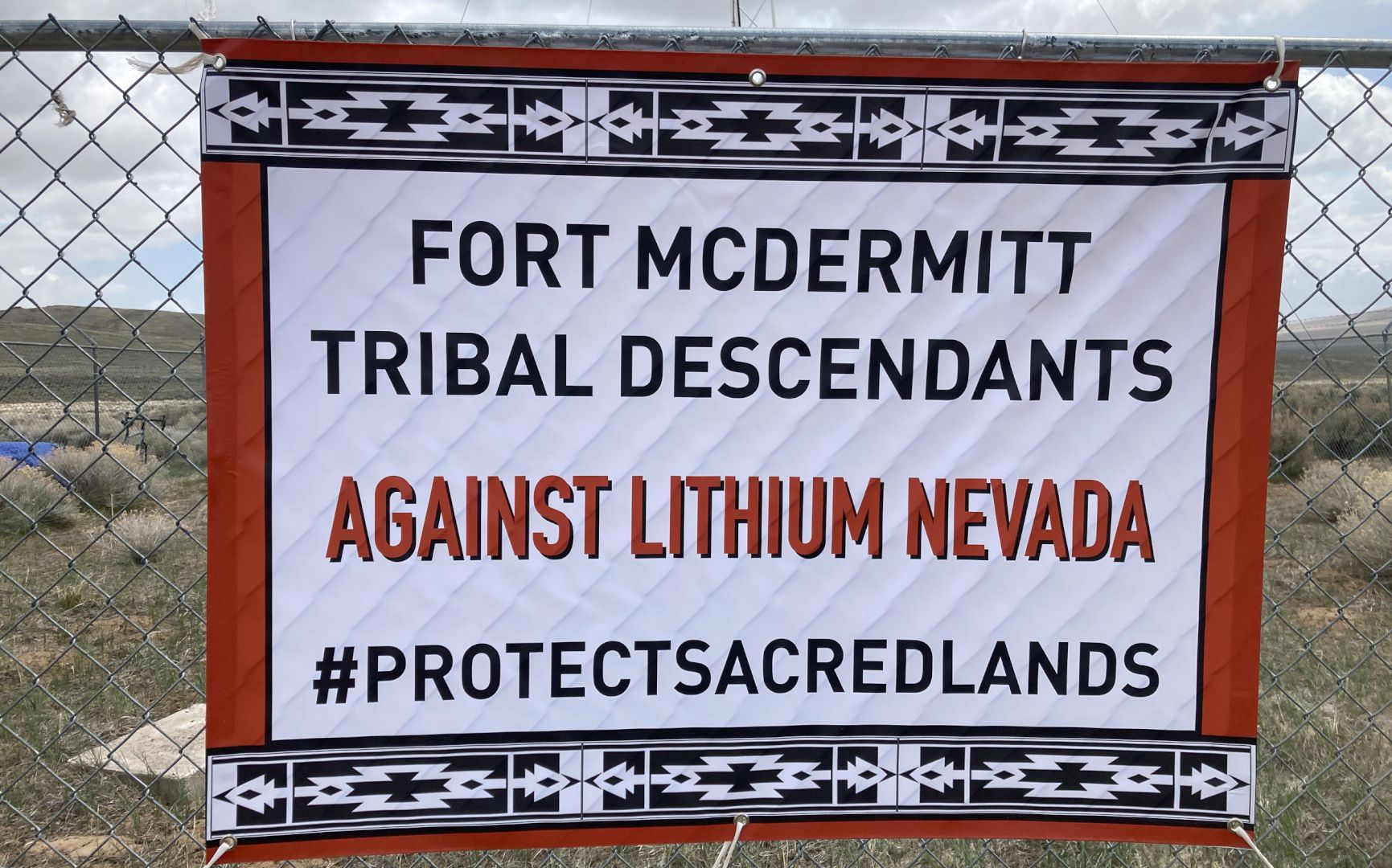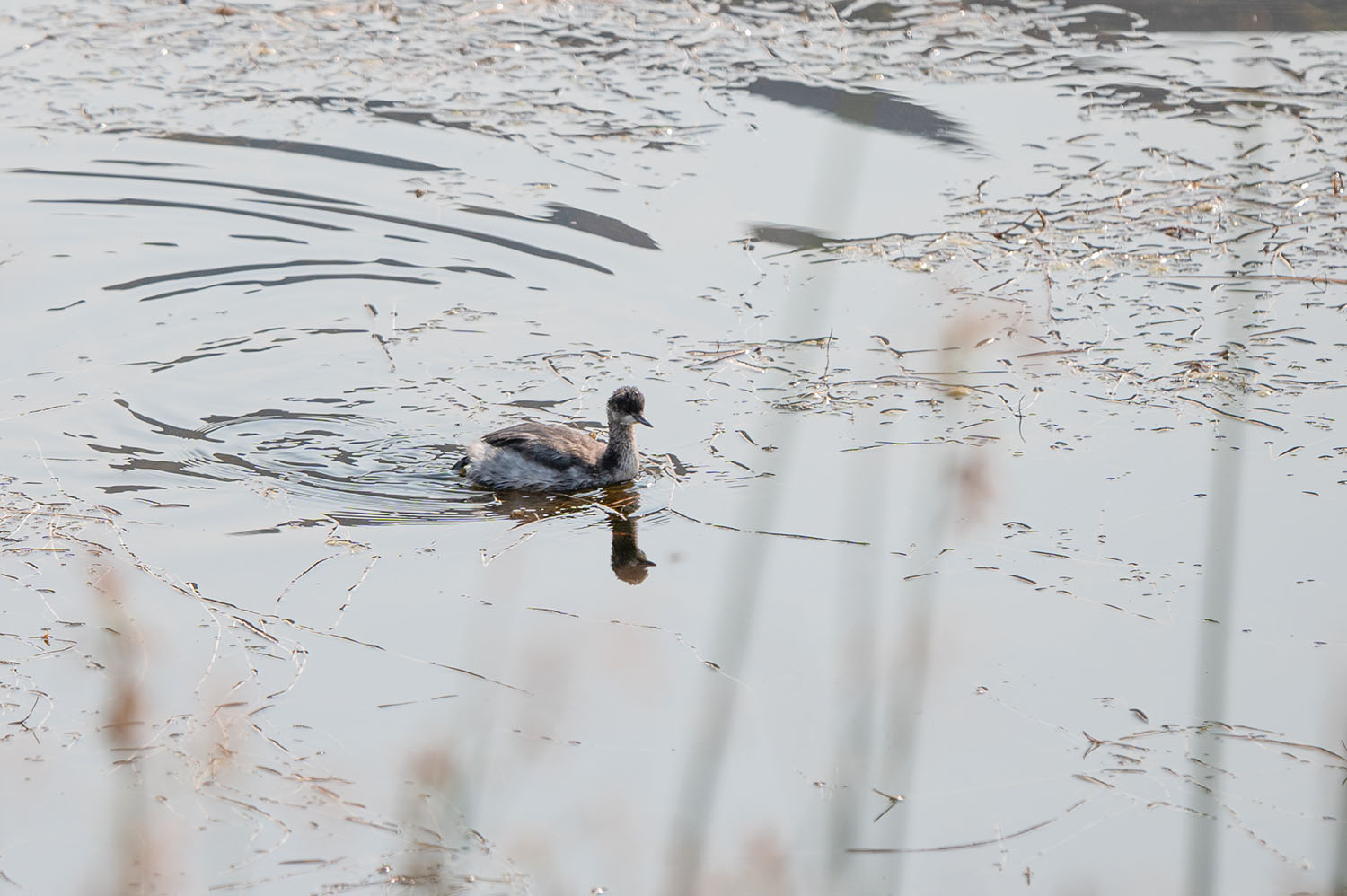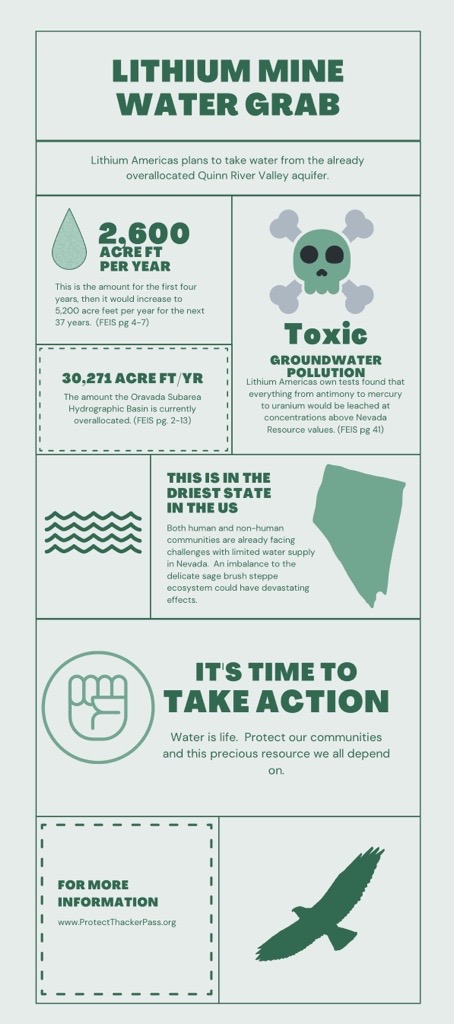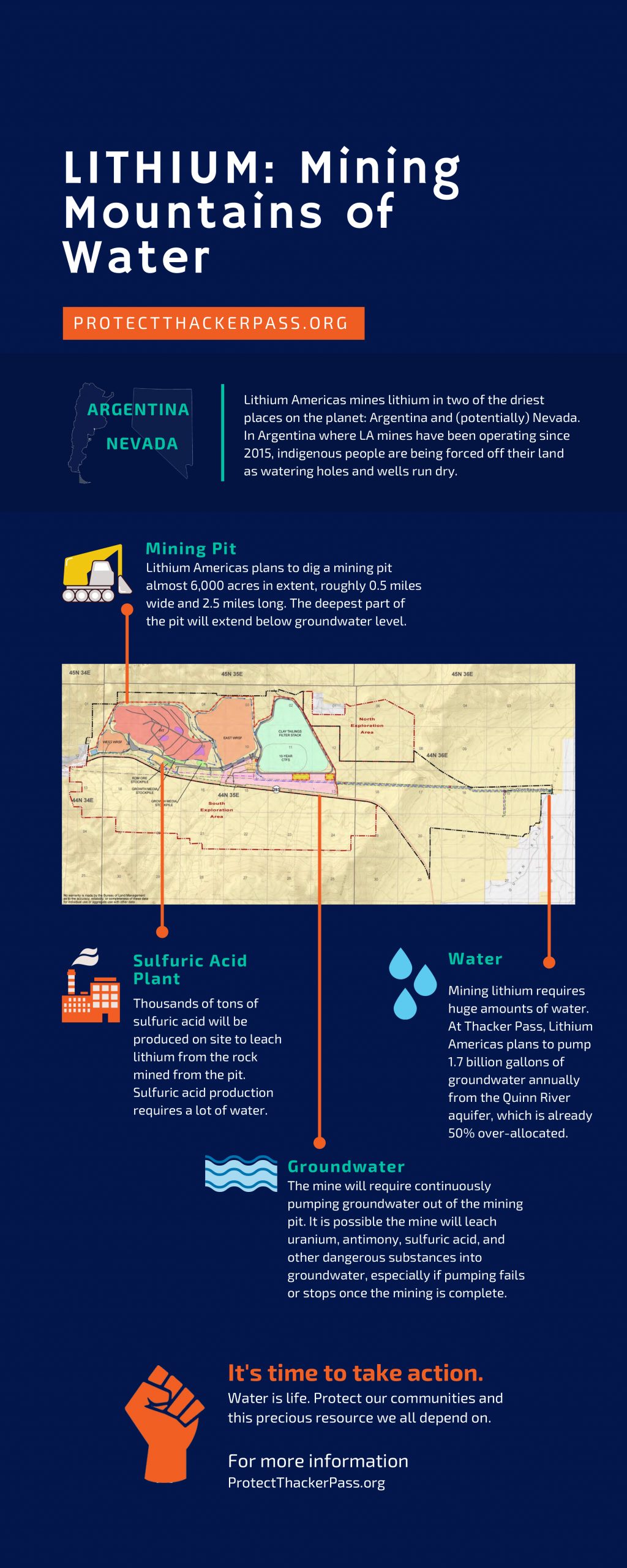![The Rush For White Gold [Dispatches from Thacker Pass]](https://dgrnewsservice.org/wp-content/uploads/sites/18/2021/06/APrice-ThackerPasssky-1080x675-1.jpg)
by DGR News Service | Jun 11, 2021 | Biodiversity & Habitat Destruction, Climate Change, Direct Action, Indigenous Autonomy, Listening to the Land, Mining & Drilling, Movement Building & Support, Obstruction & Occupation, Toxification
by Austin Price, for Earth Island Journal
SIXTEEN MILLION YEARS AGO, a volcano erupted over the Yellowstone hotspot near the present-day border of Oregon and Nevada. The blast expelled 1,000 cubic kilometers of rhyolite lava as the land collapsed into a 30-mile-long, keyhole-shaped caldera. Magma, ash, and other sediments entered the keyhole, and for the next million years the clay-rich land rose and reformed like bread dough in a proofing drawer. Water mixed with the clay, bringing to Earth’s surface a swirl of chemical elements like uranium, mercury, and another metal that, when isolated and cut, shines silvery white — lithium.
Today, above ground, the McDermitt Caldera is a remote landscape of rocky outcrops, high-desert plateaus, and meadows of wild rye. As in much of the Great Basin, desert plants fill the “currents, tides, eddies, and embayments” of this “sagebrush ocean,” as writer Stephen Trimble once described it. Lithium rests beneath this dynamic sea.
On the southwest edge of the caldera, in Humboldt County, Nevada, nestled between the Double H Mountains to the south and the Montana range to the north, Thacker Pass rides the crest of a sagebrush wave. The pass is a corridor for herds of migrating pronghorn and mule deer. Overhead, golden eagles hunt for kangaroo rats. Below, greater sage grouse perform their mating dance. In the nearby springs and drainages, an endemic snail called the Kings River pyrg and the imperiled Lahontan cutthroat trout persist on precious water.
Read the rest at Earth Island Journal.
Photo by Austin Price.
Sign the petition from People of Red Mountain: https://www.change.org/p/protect-thacker-pass-peehee-mu-huh
Donate: https://www.classy.org/give/423060/#!/donation/checkout
For more on the Protect Thacker Pass campaign
#ProtectThackerPass #NativeLivesMatter #NativeLandsMatter

by DGR News Service | May 19, 2021 | Biodiversity & Habitat Destruction, Colonialism & Conquest, Culture of Resistance, Direct Action, Indigenous Autonomy, Listening to the Land, Lobbying, Mining & Drilling, Movement Building & Support, Obstruction & Occupation, Repression at Home, Toxification, White Supremacy
In this statement, Atsa koodakuh wyh Nuwu (the People of Red Mountain), oppose the proposed Lithium open pit mines in Thacker Pass. They describe the cultural and historical significance of Thacker Pass, and also the environmental and social problems the project will bring.
We, Atsa koodakuh wyh Nuwu (the People of Red Mountain) and our native and non-native allies, oppose Lithium Nevada Corp.’s proposed Thacker Pass open pit lithium mine.
This mine will harm the Fort McDermitt Paiute-Shoshone Tribe, our traditional land, significant cultural sites, water, air, and wildlife including greater sage grouse, Lahontan cutthroat trout, pronghorn antelope, and sacred golden eagles. We also request support as we fight to protect Thacker Pass.
”Lithium Nevada Corp. (“Lithium Nevada”) – a subsidiary of the Canadian corporation Lithium Americas Corp. – proposes to build an open pit lithium mine that begins with a project area of 17,933 acres. When the Mine is fully-operational, it would use 5,200 acre-feet per year (equivalent to an average pumping rate of 3,224 gallons per minute) in one of the driest regions in the nation. This comes at a time when the U.S. Bureau of Reclamation fears it might have to make the federal government’s first-ever official water shortage declaration which will prompt water consumption cuts in Nevada. Meanwhile, despite Lithium Nevada’s characterization of the Mine as “green,” the company estimates in the FEIS that, when the Mine is fully-operational, it will produce 152,703 tons of carbon dioxide equivalent emissions every year.
Mines have already harmed the Fort McDermitt tribe.
Several tribal members were diagnosed with cancer after working in the nearby McDermitt and Cordero mercury mines. Some of these tribal members were killed by that cancer.
In addition to environmental concerns, Thacker Pass is sacred to our people. Thacker Pass is a spiritually powerful place blessed by the presence of our ancestors, other spirits, and golden eagles – who we consider to be directly connected to the Creator. Some of our ancestors were massacred in Thacker Pass. The name for Thacker pass in our language is Peehee mu’huh, which in English, translates to “rotten moon.” Pee-hee means “rotten” and mm-huh means “moon.” Peehee mu’huh was named so because our ancestors were massacred there while our hunters were away. When the hunters returned, they found their loved ones murdered, unburied, rotting, and with their entrails spread across the sage brush in a part of the Pass shaped like a moon. To build a lithium mine over this massacre site in Peehee mu’huh would be like building a lithium mine over Pearl Harbor or Arlington National Cemetery. We would never desecrate these places and we ask that our sacred sites be afforded the same respect.
Thacker Pass is essential to the survival of our traditions.
Our traditions are tied to the land. When our land is destroyed, our traditions are destroyed. Thacker Pass is home to many of our traditional foods. Some of our last choke cherry orchards are found in Thacker Pass. We gather choke cherries to make choke cherry pudding, one of our oldest breakfast foods. Thacker Pass is also a rich source of yapa, wild potatoes. We hunt groundhogs and mule deer in Thacker Pass. Mule deer are especially important to us as a source of meat, but we also use every part of the deer for things like clothing and for drumskins in our most sacred ceremonies.
Thacker Pass is one of the last places where we can find our traditional medicines.
We gather ibi, a chalky rock that we use for ulcers and both internal and external bleeding. COVID-19 made Thacker Pass even more important for our ability to gather medicines. Last summer and fall, when the pandemic was at its worst on the reservation, we gathered toza root in Thacker Pass, which is known as one of the world’s best anti-viral medicines. We also gathered good, old-growth sage brush to make our strong Indian tea which we use for respiratory illnesses.
Thacker Pass is also historically significant to our people.
The massacre described above is part of this significance. Additionally, when American soldiers were rounding our people up to force them on to reservations, many of our people hid in Thacker Pass. There are many caves and rocks in Thacker Pass where our people could see the surrounding land for miles. The caves, rocks, and view provided our ancestors with a good place to watch for approaching soldiers. The Fort McDermitt tribe descends from essentially two families who, hiding in Thacker Pass, managed to avoid being sent to reservations farther away from our ancestral lands. It could be said, then, that the Fort McDermitt tribe might not be here if it wasn’t for the shelter provided by Thacker Pass.
We also fear, with the influx of labor the Mine would cause and the likelihood that man camps will form to support this labor force, that the Mine will strain community infrastructure, such as law enforcement and human services. This will lead to an increase in hard drugs, violence, rape, sexual assault, and human trafficking. The connection between man camps and missing and murdered indigenous women is well-established.
Finally, we understand that all of us must be committed to fighting climate change. Fighting climate change, however, cannot be used as yet another excuse to destroy native land. We cannot protect the environment by destroying it.
Sign the petition from People of Red Mountain: https://www.change.org/p/protect-thacker-pass-peehee-mu-huh
Donate: https://www.classy.org/give/423060/#!/donation/checkout
For more on the Protect Thacker Pass campaign
#ProtectThackerPass #NativeLivesMatter #NativeLandsMatter
![Will Thacker Pass, At Last, Be Still? [Dispatches from Thacker Pass]](https://dgrnewsservice.org/wp-content/uploads/sites/18/2021/05/SnowAtThackerPass-980x735-1.jpg)
by DGR News Service | May 5, 2021 | Biodiversity & Habitat Destruction, Indigenous Autonomy, Listening to the Land, Mining & Drilling, Movement Building & Support, Obstruction & Occupation, Repression at Home, Toxification
On a late April morning in Thacker Pass, where some Paiute ancestors have been buried and some massacred, where some people want to dig out the dead to dig out lithium, I woke to a strange, wet snow that fell overnight a day before temperatures in the 70s were forecast. It seemed a bad omen.
By Will Falk
Paiute elders teach that very bad things happen when the dead are disturbed. I knew this must be true. So many industrial projects in so many places have destroyed so many burial sites. The cracked bones of the slain have been cracked again and again in the frantic search for coal. Old, spilled blood turned to soil has been mixed with new, spilled blood by those who murder for oil. Now, in Nevada, if the lithium miners have their way, those brave Paiute who died resisting American soldiers will finally be forced onto the reservation when machinery agitates the dust formed by those Paiute bodies and the wind blows that dust to coat the homes of Paiute descendants at Fort McDermitt.
Either these desecrations have caused the world to go to hell or the dead, disturbed, have brought hell to Earth.
I pondered this while pondering the surreality of the spring snow. As heavy as it was, the snow didn’t weigh the ghosts down. Fingers that once clawed with shock at bullet holes, clawed through mud made by their own blood. The ghosts climbed through the sage brush roots and volcanic rocks, to drift over the snow and confront the living with the reality of history. Moans moved with heavy clouds. Screams, sometimes, did too. Raven wings stirred the death hanging on the air. The wind blew with their last words in a language I never knew.
Though the language was strange to me, the meaning was clear enough: each generation’s missing and murdered grieve for the next. A meadowlark, landed on the tip of a nearby sagebrush, and began to sing. He sang: “While there’s still time for some, there’s no time for grief.” He told me to let them grieve.
I threw some cedar on the fire and watched my prayers rise with the smoke. I wondered what the wind will do when there are no more dying words to deliver, what the dead will do when they are confident they will not be disturbed, what the ghosts will do when their lessons are remembered. I wondered: Will Thacker Pass, at last, be still?
You can find out more and support Thacker Pass:

by DGR News Service | May 4, 2021 | Biodiversity & Habitat Destruction, Climate Change, Listening to the Land, Mining & Drilling, Movement Building & Support, Toxification
In this article Rebecca Wildbear talks about how civilization is wasting our planet’s scarce water sources for mining in its desperate effort to continue this devastating way of life.
By Rebecca Wildbear
Nearly a third of the world lacks safe drinking water, though I have rarely been without. In a red rock canyon in Utah, backpacking on a week-long wilderness training in my mid-twenties, it was challenging to find water. Eight of us often scouted for hours. Some days all we could find to drink was muddy water. We collected rain water and were grateful when we found a spring.
Now water is scarce, and the demand for it is growing. Globally, water use has risen at more than twice the rate of population growth and is still increasing. Ninety percent of water used by humans is used by industry and agriculture, and when groundwater is overused, lakes, streams and rivers dry up, destroying ecosystems and species, harming human health, and impacting food security. Life on Earth will not survive without water.
In the Navajo Nation in Arizona, Utah, and New Mexico, a third of houses lack running water, and in some towns, it is ninety percent. Peabody Energy Corporation, the largest coal producer and a Fortune 500 company, pulled so much water from the Navajo aquifer before closing its mining operation that many wells and springs have run dry. Residents now have to drive 17 miles to wait in line for an hour at a communal well, just to get their drinking water.

Worldwide, the majority of drinkable water comes from underground reservoirs called aquifers. Aquifers feed streams, lakes, and rivers, but their waters are finite. Large aquifers exist beneath deserts, but these were created eons ago in wetter times. Expert hydrologists say that like oil, once the “fossil” waters of ancient reservoirs are mined, they are gone forever.
Peabody’s Black Mesa Mine extracted, pulverized, and mixed coal with water drawn from the Navajo aquifer to form a slurry. This was sent along a 273-mile-long pipeline to the Mojave Generating Station in Laughlin, Nevada, to power Los Angeles. Every year, the mine extracted 1.4 billion gallons (4,000+ acre feet) of water from the aquifer, an estimated 45 billion gallons (130,000+ acre feet) in all.
Pumping out an aquifer draws down the water level and empties it forever. Water quality deteriorates and springs and soil dry out. Agricultural irrigation and oil and coal extraction are the biggest users of waters from aquifers in the U.S. Some predict that the Ogallala aquifer, once stretching beneath five mid-western states, may be able to replenish after six thousand years of rainfall.
Rain is the most accurate measure of available water in a region, yet over-pumping water beyond its capacity to refill is widespread in the western U.S. and around the world. The Middle East ran out of water years ago—it was the first major region in the world to do so. Studies predict that two thirds of the world’s population are at risk of water shortages by 2025. As ground water levels fall, lakes, rivers, and streams are depleted, and the land, fish, trees, and animals die, leaving a barren desert.

Mining in the Great Basin
The skyrocketing demand for lithium, one of the minerals needed for the production of electric cars, is based on the misperception that green technology helps the planet. Yet, as Argentine professor of thermodynamics and lithium mining expert Dr. Daniel Galli said at a scientific meeting, lithium mining is “really mining mountains of water.” Lithium Americas plans to pump massive amounts of water—up to 1.7 billion gallons (5,200 acre feet) annually—from an aquifer in the Quinn River Valley in Nevada’s Great Basin, the largest desert in the United States.
Thacker Pass, the site of the proposed 1.3 billion dollar open-pit lithium mine, would pump 1,200 acre feet more water per year than Peabody Energy Corporation extracted from the Navajo aquifer. Yet, the Quinn River aquifer is already over-allocated by fifty percent, and more than 10 billion gallons (30,000 acre feet) per year. Nevada is one of the driest states in the nation, and Thacker Pass is only the first of many proposed lithium mines in the state. Multiple active placer claims (7,996) have been located in 18 different hydrographic basins.
Deceit about water fuels these mines. Lithium Americas’ environmental impact assessment is grossly inaccurate, according to hydrologist Dr. Erick Powell. By classifying year-round creeks as “ephemeral” and underreporting the flow rate of 14 springs, Lithium Americas is claiming there is less water in the area than there actually is. This masks the real effects the mine would have—drying up hundreds of square miles of land, drawing down the groundwater level, sucking water from neighboring aquifers—all while claiming its operations would have no effect.
Peabody Energy Corporation’s impact assessment similarly misrepresented how their withdrawals would harm the Navajo aquifer. Peabody Energy used a flawed method to measure the withdrawals, according to former National Science Research Fellow Daniel Higgins. Now Navajo Nation wells require drilling down 2,000–3,000 feet, and the water is depressurized and slow to flow to the surface.
Thacker Pass lithium mine would pump groundwater at a disturbing rate, up to 3,250 gallons per minute. Once used, wastewater would contaminate local groundwater with dangerous heavy metals, including a “plume” of antimony that would last at least 300 years. Lithium Americas plans to dig the mine deeper than the groundwater level and keep it dry by continuously pumping water out, but when the pumping stops, groundwater would seep back in, picking up the toxins.
It hurts me to think about this. I imagine water being rapidly extracted from my own body, my bloodstream poisoned. The best tasting water rises to the surface when it is ready, after gestating as long as it likes in the dark Earth. Springs are sacred. When I feel welcome, I place my lips on the earthy surface and fill my mouth with their sweet flavor and vibrant texture.
Mining in the Atacama Desert
Thirteen thousand feet above sea level, the indigenous Atacamas people live in the Atacama Desert, the most arid desert in the world and the driest place on Earth. For millennia, they have used their scarce supply of water and sparse terrain carefully. Their laws and spirituality have always been intertwined with the health and well-being of the land and water. Living in mud-brick homes, pack animals, llama and alpaca, provide them with meat, hide, and wool.
But lithium lies beneath their ancestral land. Since 1980, mining companies have made billions in the Salar de Atacama region in Chile, where lithium mining now consumes sixty-five percent of the water. Some local communities need to have water driven in, and other villagers have been forced to abandon their settlements. There is no longer enough water to graze their animals. Beautiful lagoons hundreds of flamingos call home have gone dry. The birds have disappeared, and the ground is hard and cracked.
In addition to the Thacker Pass mine proposal, Lithium Americas has a mine in the Atacama Desert, a joint Canadian-Chilean venture named Minera Exar in the Cauchari-Olaroz basin in Jujuy, Argentina. Digging for lithium began in Jujuy in 2015, and there is already irreversible damage, according to a 2018 hydrology report. Watering holes have gone dry, and indigenous leaders are scared that soon there will be nothing left.
Even more water is needed to mine the traces of lithium found in brine than in an open-pit mine. At the Sales de Jujuy plant, the wells pump at a rate of more than two million gallons per day, even though this region receives less than four inches of rain a year. Pumping water from brine aquifers decreases the amount of fresh groundwater. Freshwater refills the spaces emptied by brine pumping and is irreversibly mixed with brine and salinized.
The Sanctity of Water
As a river guide, I live close to water. Swallowed by its wild beauty, I am restored to a healthier existence. Far from roads, cars, and cities, I watch water swirl around rocks or ripple over sand. I merge with its generous flow, floating through mountains, forest, or canyon. Rivers teach me how to listen to the currents—whether they cascade in a playful bubble, swell in a loud rush, or ebb in a gentle silence—for clues about what lies ahead.
The indigenous Atacamas peoples understand that water is sacred and have purposefully protected it for centuries. Rather than looking at how nature can be used, our culture needs to emulate the Atacamas peoples and develop the capacity to consider its obligations around water. Instead of electric cars, what we need is an ethical approach to our relationship with the land. Honoring the rights of water, species, and ecosystems is the foundation of a sustainable society. Decisions can be made based on knowledge of the land, weather patterns, and messages from nature.
For millennia, indigenous peoples have perceived water, animals, and mountains as sentient. If humans today could recognize their intelligence, perhaps they would understand that underground reservoirs have a value and purpose, beyond humans. When I enter a cave, I am walking into a living being. My eyes adjust to the dark. Pressing my hand against the wall, I steady myself on the uneven ground, hidden by varying amounts of water. Pausing, I listen to a soft dripping noise, echoing like a heartbeat as dew slides off the rocks. I can almost hear the cave breathing.
The life-giving waters of aquifers keep everything alive, but live unseen under the ground. As a soul guide, I invite people to be nourished by the visions of their dreams, a parallel world that is also seemingly invisible. Our dominant culture dismisses the value of these perceptions, just as it usurps water by disregarding natural cycles. Yet to create a sustainable world, humans need to be able to listen to nature and their dreams. The depths of our souls are inextricably linked to the ancient waters that flow underground. Dreams arise like springs from an aquifer, seeding our visionary potential, expanding our consciousness, and revealing other ways to live, radically different than empire.
Water Bearers
I set my backpack down on a high sandstone cliff overlooking a large watering hole. Ten feet below the hole, the red rock canyon drops into a much larger pool. My friend hikes down to it, filling her cookpot with water. She balances it atop her head on the way up, moving her hips to keep the pot steady. Arriving back, she pours the water into the smaller hole from which we drink and returns to the large pool to gather more.
Women in all societies have carried water throughout history. In many rural communities, they still spend much of the day gathering it. Sherri Mitchell of the Penobscot Nation calls women “the water bearers of the Universe.” The cycles in a woman’s body move in relation with the Earth’s tides, guiding them to nourish and protect the waters of Earth. We all need to become water bearers now.
Indigenous peoples, who have always been the Earth’s greatest defenders, protect eighty percent of global diversity, even though they comprise less than five percent of the world’s population. They understand water is sacred, and the world’s groundwater systems must be defended. For six years, indigenous peoples have been fighting to prevent lithium mining in the Salinas Grandes salt flats, in Jujuy, Argentina. Five hundred indigenous people camped on the land with signs: “No to lithium. Yes, to water and life in our territories.”
In February 2021, President Biden signed executive orders supporting the domestic mining of “critical” minerals like lithium, but two lawsuits, one by five Nevada-based conservation groups, have been filed against the Bureau of Land Management for approving the Thacker Pass lithium mine. Environmentalists Max Wilbert and Will Falk are organizing a protest to protect Thacker Pass. Local residents, including Northern Paiute and Western Shoshone peoples, are speaking out, fighting to protect their land and water.
We can see when a river runs dry, but most people are not aware of the invisible, slow-burning disaster happening under the ground. Some say those who oppose lithium mining should give up cell phones. If that is true, perhaps those who favor mines should give up drinking water. Protecting water needs to be at the center of any plan for a sustainable future.
The “fossil water” found in deserts should be used only in emergency, certainly not for mining. Sickened by corporate water grabbing, I support those trying to stop Thacker Pass Lithium mine and aim to join them. The aquifers there have nurtured so many for so long—eagles, pronghorn antelope, mule deer, old-growth sagebrush, hawks, falcons, sage-grouse, and Lahontan cutthroat trout. I pray these sacred wombs of the Earth can live on to nourish all of life.
For more on the issue:
![The Rush For White Gold [Dispatches from Thacker Pass]](https://dgrnewsservice.org/wp-content/uploads/sites/18/2021/06/APrice-ThackerPasssky-1080x675-1.jpg)



![Will Thacker Pass, At Last, Be Still? [Dispatches from Thacker Pass]](https://dgrnewsservice.org/wp-content/uploads/sites/18/2021/05/SnowAtThackerPass-980x735-1.jpg)


